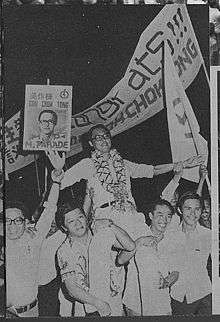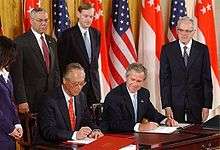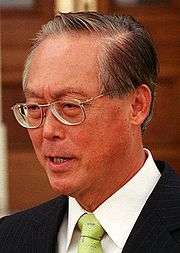Goh Chok Tong
| The Honourable Goh Chok Tong MP | |||||||||||||||||
|---|---|---|---|---|---|---|---|---|---|---|---|---|---|---|---|---|---|
| 吴作栋 | |||||||||||||||||
|
Goh Chok Tong speaking to a reporter outside The Pentagon, United States on 14 June 2001 | |||||||||||||||||
| 2nd Prime Minister of Singapore | |||||||||||||||||
|
In office 28 November 1990 – 12 August 2004 | |||||||||||||||||
| President |
See list
| ||||||||||||||||
| Deputy |
See list
| ||||||||||||||||
| Preceded by | Lee Kuan Yew | ||||||||||||||||
| Succeeded by | Lee Hsien Loong | ||||||||||||||||
| Senior Minister of Singapore | |||||||||||||||||
|
In office 12 August 2004 – 21 May 2011 Serving with S. Jayakumar (2009-2011) | |||||||||||||||||
| President | S.R. Nathan | ||||||||||||||||
| Prime Minister | Lee Hsien Loong | ||||||||||||||||
| Preceded by | Lee Kuan Yew | ||||||||||||||||
| Succeeded by | Himself (ESM) | ||||||||||||||||
| Secretary-General of the People's Action Party | |||||||||||||||||
|
In office November 1992 – December 2004 | |||||||||||||||||
| Preceded by | Lee Kuan Yew | ||||||||||||||||
| Succeeded by | Lee Hsien Loong | ||||||||||||||||
| Member of Parliament for Marine Parade GRC (Marine Parade) Marine Parade SMC (1976-1988) | |||||||||||||||||
|
Assumed office 1988 | |||||||||||||||||
| Personal details | |||||||||||||||||
| Born |
20 May 1941 Singapore, Straits Settlements | ||||||||||||||||
| Political party | People's Action Party (1976) | ||||||||||||||||
| Spouse(s) | Tan Choo Leng | ||||||||||||||||
| Children |
Goh Jin Hian Goh Jin Theng | ||||||||||||||||
| Alma mater |
University of Singapore, Williams College | ||||||||||||||||
| Signature |
 | ||||||||||||||||
| Chinese name | |||||||||||||||||
| Simplified Chinese | 吴作栋 | ||||||||||||||||
| Traditional Chinese | 吳作棟 | ||||||||||||||||
| |||||||||||||||||
Goh Chok Tong (born 20 May 1941; Chinese: 吴作栋; pinyin: Wú Zuòdòng, Wade–Giles: Wu2-tso4-tung4) is a Singaporean politician. A member of the People's Action Party (PAP), he became Singapore's second Prime Minister on 28 November 1990, succeeding Lee Kuan Yew, and served in the role until 12 August 2004, when he stepped down and was succeeded by Lee Hsien Loong. He subsequently served as Senior Minister until May 2011, and as Chairman of the Monetary Authority Of Singapore (MAS). He continues to serve as a Member of Parliament (MP) representing the Marine Parade Group Representation Constituency and holds the honorary title of "Emeritus Senior Minister".
Early life
Goh's father was from Yongchun County, Fujian province, China, while he was born in Singapore. His family is Hokkien.[1][2] Goh studied at Raffles Institution from 1955 to 1960. He was a very competitive swimmer in his younger days and was given the nickname "Bold".
Goh earned a Bachelor of Arts degree with first class honours in economics from the University of Singapore (now National University of Singapore), and a Master of Arts in development economics from Williams College in 1967. After his studies, Goh returned to Singapore to serve in the Administrative Service.[3] Goh's dream of getting a PhD was disrupted, as the government would not transfer his bursary bond to the university, where he had signed on as a research fellow after graduation. In 2015, Goh was awarded the highest recognition from his alma mater, NUS, the honorary degree of Doctor of Laws, which was presented to him for his contributions to Singapore in public service.[4]
Career at Neptune Orient Lines, 1969 to 1977
In 1969, Goh was seconded to the shipping company Neptune Orient Lines (NOL) as a Planning and Projects Manager. His career advanced quickly and by 1973, he became the Managing Director and led NOL to achieve impressive financial results during his tenure. Here Goh worked under Muhammad Jalaluddin Sayeed, with whom he maintained close ties.[5]
Early political career

In the 1976 Singapore general election, at the age of 35, Goh was elected as Member of Parliament for Marine Parade Group Representation Constituency, as a People's Action Party (PAP) candidate. He was appointed a Senior Minister of State for Finance. In 1981, he was promoted to Minister for Trade and Industry and later served in other appointments including Minister for Health and Minister for Defence.[6]
In 1985, Goh became the first Deputy Prime Minister and began to assume the responsibility of the government in a carefully managed leadership transition. According to Lee Kuan Yew, his preferred successor was Tony Tan; however Goh was selected by the second generation of PAP leaders that included Tony Tan, Suppiah Dhanabalan, and Ong Teng Cheong, and Lee accepted their decision.[3]
Prime Minister, 1990 to 2004

On 28 November 1990, Goh became the second Prime Minister of Singapore, taking over from Lee Kuan Yew. Lee remained an influential member of his Cabinet, holding the post of Senior Minister. The 1991 general elections, the first electoral test for Goh, led to the party winning 61% of the popular vote. In 1992, Lee Kuan Yew handed over the post of Secretary General of People's Action Party to Goh, successfully completing the leadership transition.
As Prime Minister, Goh promised a more open-minded and consultative style of leadership than that of his predecessor. This greater openness extended also to the socio-economic spheres of life, for instance, in his support for the rise of "little bohemias" in Singapore, enclaves where more creativity and entrepreneurship could thrive.[7]
His administration introduced several major policies and policy institutions, including:
- Medisave
- Non-Constituency Members of Parliament
- Government Parliamentary Committees
- Group representation constituency
- Nominated Members of Parliament
- Vehicle Quota Scheme
- Elected President
- Singapore 21
During the period under Goh's administration, Singapore experienced several crises, such as the 1997 Asian financial crisis, threats of terrorism including the 2001 Singapore embassies attack plot by Jemaah Islamiyah, the 2001-2003 economic recession, and the 2003 SARS outbreak.
As Secretary General, Goh led the PAP to three general election victories in 1991, 1997, and 2001, in which the party won 61%, 65% and 75% of the votes respectively. After the general election in 2001, Goh indicated that he would step down as Prime Minister after leading the country out of the recession.[3]
During an interview with the magazine Time in July 2003, Goh surprised his nation by announcing that his government is now openly employing gays, even in sensitive jobs, despite homosexual acts remaining illegal under Section 377A of the Penal Code (Singapore).[8] His announcement drew a strong backlash from conservatives of the island nation but nevertheless reinforced Goh's image as an open-minded leader.
Senior Minister, 2004 to 2011

On 12 August 2004, Goh stepped down as Prime Minister and began service as Senior Minister in Lee Hsien Loong's Cabinet. On 20 August 2004, Goh assumed the post of Chairman of the Monetary Authority of Singapore.[9] After a number of threats of terrorism in Singapore, Goh met local Islamic religious leaders in 2004, and made a visit to Iran, where he met Iranian president Mohammad Khatami, and visited local mosques.
Goh subsequently visited other Middle-Eastern countries as Senior Minister, with a view to improving diplomatic relationships and thus gaining wider business opportunities for Singaporean businessmen, especially in the United Arab Emirates, Qatar, and Kuwait.
On 1 February 2005, Goh was appointed an honorary Companion of the Order of Australia (AC), Australia's highest civilian honour, "for eminent service to Australia/Singapore relations".[10]
On 19 May 2005, Goh signed a Double Taxation Avoidance Agreement with Israel's Finance Minister Benjamin Netanyahu on a visit to Israel, superseding the agreement signed in 1971. Improvements in the agreement include enhancements to the withholding tax rate on interest income, which was reduced from 15% to 7%. This would benefit Singaporean businessmen with investments in Israel and vice versa, by ensuring they are not taxed twice.
He currently is a patron for the Institute of Policy Studies, a government think tank.
In the Singapore general election, 2006, Goh was tasked to help the PAP win back the two opposition wards of Hougang and Potong Pasir.[11] However, he was unsuccessful in this task, as Low Thia Khiang and Chiam See Tong retained their respective wards.
In 2006, Goh was briefly considered for the job of United Nations Secretary-General. The job eventually went to Ban Ki-moon.[9][12]
In 2008, Goh was invited to join the InterAction Council of Former Heads of State and Government, an independent international organisation of former world leaders.
On 24 January 2011, Goh announced that he would continue to seek re-election to Parliament at the 2011 general election. Over the following months, he progressively released snippets prior to the election on the importance of grooming a successor who could be part of the fourth generation PAP leadership to helm Marine Parade GRC in the long run.
Emeritus Senior Minister, from 2011
After the 2011 general election, in which the opposition made unprecedented gains by winning a group representative constituency (Aljunied), Goh and Lee Kuan Yew announced that they were retiring from the Cabinet in order to give Prime Minister Lee Hsien Loong and the rest of his team a clean slate from which they can make a fresh start in the new parliamentary term.[13]
On 18 May 2011, Lee Hsien Loong announced that Goh was to be appointed a senior advisor to the Monetary Authority of Singapore (MAS), and would be given the honorary title of "Emeritus Senior Minister".[14]
On 24 June 2011, Goh was awarded the Grand Cordon of the Order of the Rising Sun by the Japanese government.[15]
On 4 May 2012, Goh was appointed as Patron for Advancement of the Singapore University of Technology and Design[16]
In October 2014, the Madame Tussauds Singapore museum unveiled a wax figure of Goh. At its opening, Goh posed for pictures with his statue.[17]
Family
| Wikiquote has quotations related to: Goh Chok Tong |
Goh is married to Tan Choo Leng and they have a son and a daughter, who are twins. Their son, Goh Jin Hian, is a medical doctor and their daughter, Goh Jin Theng, lives in London with her English husband, Lee Craven.
References
- ↑ 闽籍华侨华人社团
- ↑ 吴作栋 新加坡前总理吴作栋盛赞千岛湖开元]
- 1 2 3 Mauzy, Diane K. and R.S. Milne (2002). Singapore Politics Under the People's Action Party. Routledge ISBN 0-415-24653-9
- ↑ http://www.straitstimes.com/singapore/nus-confers-honorary-degrees-on-esm-goh-prof-saw-and-sir-richard-sykes
- ↑ Sayeed of Singapore, By Ardeshir Cowasjee, Dawn newspaper, 25 September 2005
- ↑ Goh Chok Tong, Cabinet of Singapore
- ↑ Quoted in "Singapore can become an entrepreneurial society" by Eugene Low, The Business Times, 19 August 2002, and analysed in Brand Singapore: How Nation Branding Built Asia's Leading Global City by Koh Buck Song, Marshall Cavendish 2011, page 160.
- ↑ "Singapore letting gays halfway out of the closet - smh.com.au". www.smh.com.au. Retrieved 2015-12-20.
- 1 2
- ↑ It's an Honour: AC
- ↑
- ↑
- ↑ "SM Goh, MM Lee to leave Cabinet". Channel NewsAsia. Singapore. 14 May 2011.
- ↑ "PM Lee announces sweeping changes to Cabinet". Channel NewsAsia. Singapore. 18 May 2011.
- ↑ "Goh Chok Tong to receive award from Japanese emperor". ChannelNewsAsia. Retrieved 19 June 2011.
- ↑ "ESM Goh appointed Patron for Advancement of SUTD". ChannelNewsAsia. Retrieved 19 June 2011.
- ↑ "PM Lee, ESM Goh to have wax figures at Madame Tussauds Singapore". Singapore Press Holdings. The Straits Times. 22 October 2014. Retrieved 27 October 2014.
Bibliography
- Impressions of the Goh Chok Tong Years in Singapore by Bridget Welsh, James Chin, Arun Mahizhnan and Tan Tarn How (Editors), Singapore: NUS Press, 2009.
- Brand Singapore: How Nation Branding Built Asia's Leading Global City by Koh, Buck Song. Marshall Cavendish, Singapore, 2011. ISBN 978-981-4328-15-9.
- Article on civil society in the Goh Chok Tong era - "What plants will grow under the tembusu tree?" by Koh Buck Song, The Straits Times 9 May 1998.
External links
| Library resources about Goh Chok Tong |
| By Goh Chok Tong |
|---|
| Political offices | ||
|---|---|---|
| Preceded by ? |
Senior Minister of State for Finance 1977-1979 |
Succeeded by S. Dhanabalan |
| Preceded by new post |
Minister for Trade and Industry 1979-1981? |
Succeeded by ? |
| Preceded by Toh Chin Chye |
Minister for Health 1981-1982? |
Succeeded by Howe Yoon Chong |
| Preceded by Howe Yoon Chong |
Minister for Defence 1982-1991 |
Succeeded by Yeo Ning Hong |
| Preceded by Goh Keng Swee |
Deputy Prime Minister of Singapore 1985–1990 |
Succeeded by Lee Hsien Loong |
| Preceded by Lee Kuan Yew |
Prime Minister of Singapore 28 November 1990 – 12 August 2004 | |
| Senior Minister 12 August 2004–2011 |
Position abolished | |
| Parliament of Singapore | ||
| New constituency | Member of Parliament for Marine Parade 1976-1988 |
Constituency abolished |
| Member of Parliament for Marine Parade GRC 1988–present |
Incumbent | |
| Party political offices | ||
| Preceded by Lee Kuan Yew |
Secretary General of People's Action Party 1992-2004 |
Succeeded by Lee Hsien Loong |
| Diplomatic posts | ||
| Preceded by Corazon Aquino |
Chairperson of ASEAN 1992 |
Succeeded by Banharn Silpa-archa |
